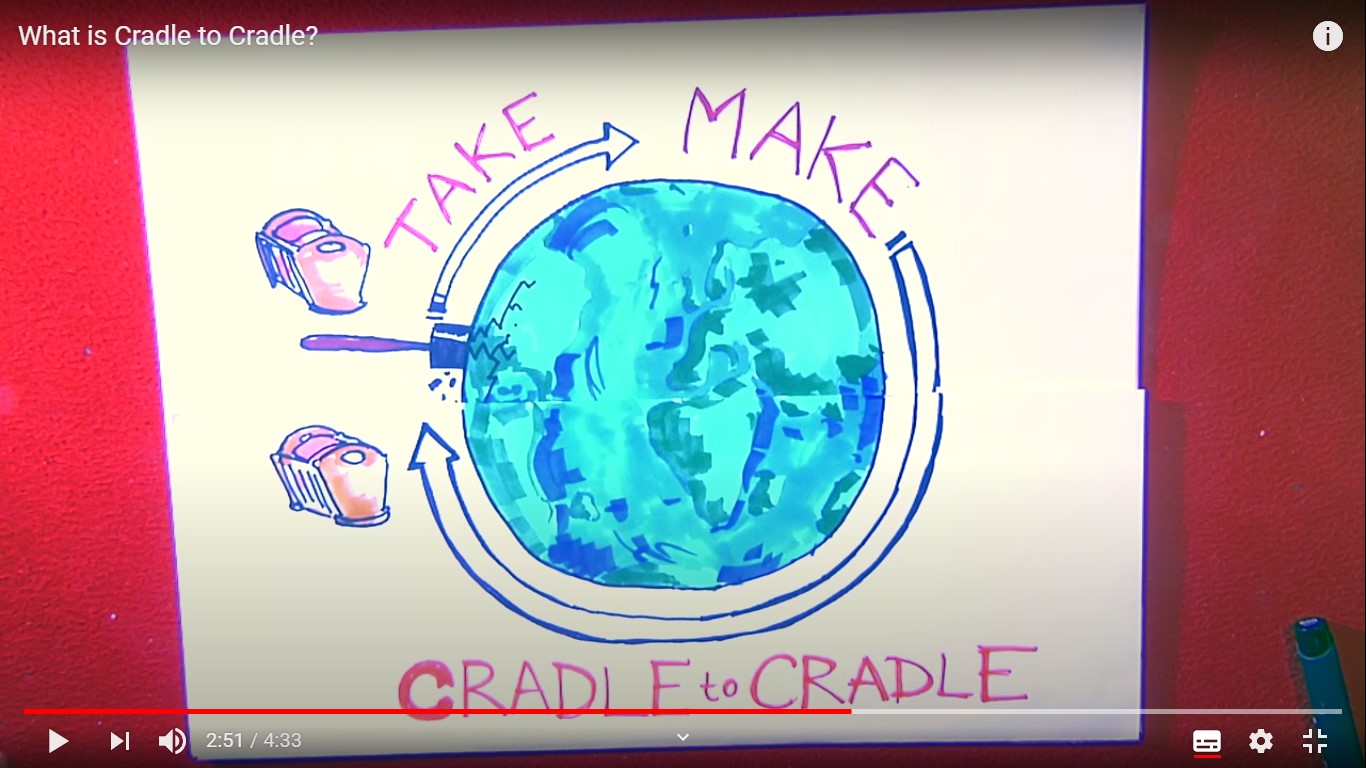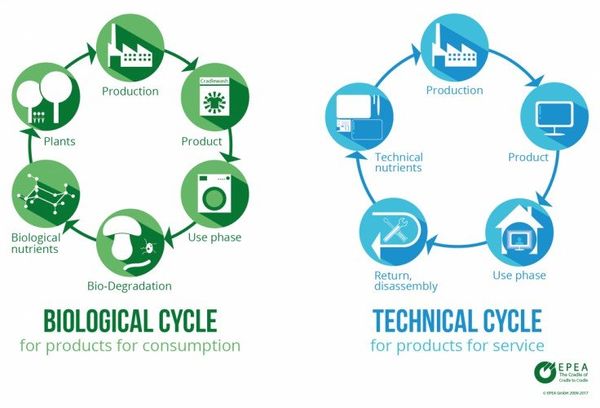Difference between revisions of "Cradle to Cradle"
| Line 1: | Line 1: | ||
{{Article | {{Article | ||
| + | |Image=C2Cimage.jpg | ||
|Summary=Cradle to Cradle is a theory by architect Mc Donough and chemist Micheal Braungart. They wrote a book in 2002 called Remaking the way we make things. In this book they showed an integration of design and science that provides enduring benefits for society from saving materials, water and energy in circular economies and it eliminated the concept of waste. Cradle to Cradle is the opposite of Cradle to Grave. Cradle to Grave applies more to our economy today Cradle to Grave: we use our earth as a source for raw materials as if natural resources were infinitely available. We extract them, make products from them and dispose of them. This principle is called “Cradle to Grave”. Unfortunately, products no longer needed end up in places that were never meant for garbage disposal with fatal consequences for humans, animals and the environment. | |Summary=Cradle to Cradle is a theory by architect Mc Donough and chemist Micheal Braungart. They wrote a book in 2002 called Remaking the way we make things. In this book they showed an integration of design and science that provides enduring benefits for society from saving materials, water and energy in circular economies and it eliminated the concept of waste. Cradle to Cradle is the opposite of Cradle to Grave. Cradle to Grave applies more to our economy today Cradle to Grave: we use our earth as a source for raw materials as if natural resources were infinitely available. We extract them, make products from them and dispose of them. This principle is called “Cradle to Grave”. Unfortunately, products no longer needed end up in places that were never meant for garbage disposal with fatal consequences for humans, animals and the environment. | ||
|Article=Cradle to Cradle: there is no waste, Waste is simply a valuable resource in the wrong place. We should see nature as our role model, and try to keep our materials flowing in cycles. This principle is called “Cradle to Cradle. Cradle to Cradle aims for: - Reducing raw material consumption - Producing less waste - Decreasing carbon dioxide emissions - Setting a long-term goal of zero emissions | |Article=Cradle to Cradle: there is no waste, Waste is simply a valuable resource in the wrong place. We should see nature as our role model, and try to keep our materials flowing in cycles. This principle is called “Cradle to Cradle. Cradle to Cradle aims for: - Reducing raw material consumption - Producing less waste - Decreasing carbon dioxide emissions - Setting a long-term goal of zero emissions | ||
Revision as of 20:34, 14 December 2020
Contents
The wikipage input value is empty (e.g. SomeProperty::, [[]]) and therefore it cannot be used as a name or as part of a query condition.
Cradle to Cradle: there is no waste, Waste is simply a valuable resource in the wrong place. We should see nature as our role model, and try to keep our materials flowing in cycles. This principle is called “Cradle to Cradle. Cradle to Cradle aims for: - Reducing raw material consumption - Producing less waste - Decreasing carbon dioxide emissions - Setting a long-term goal of zero emissions
The cradle to cradle theory is a design framework of 3 principles inspired by nature:
- Keeping all materials in continuous cycles. So everything is a resource for something else. In nature the waste of one system becomes food for another. Mc Donough and Braungart are saying that every part of a product can be designed with the intention of bringing it back in the technical or biological cycle
- Use clean and renewable energy. We can utilize clean and renewable energy in many forms, such as solar or wind energy. These resources are endless and supporting human and environmental health
- Celebrate diversity. Designs that respond to the challenges and opportunities offered by each place fit elegantly and effectively into their own niches So in cradle to cradle design we are no longer using materials but we borrow them. Ten waste would no longer exist. This paradigm shift reveals opportunities to improve quality, increase value and stimulates innovation. It inspires us to constantly seek improvement in our designs and to share discoveries with others. We have to distinguish between a biological and a technological cycle.
Biological cycle: includes everything that can wear out in the environment. These materials have to be fully biodegradable without releasing any harmful substances. Technical cycle: contains everything that is not biodegradable and should be prevented from entering the environment. With the Cradle to Cradle approach, we can not only reduce our negative ecological footprint but extend our positive footprint. That means already while designing a product we have to be aware of the fate of all of its components at the end of the product’s life cycle. In the long term, we would then be able to live in harmony with nature again, without lowering our standard of living. Example 1: The Cradle to Cradle book.
The book was published in 2002 by North Point Press. The book itself is printed using DuraBook technology. The pages are not pater, but rather synthetics created from plastic resins and inorganic fillers. The books are more durable and strong than traditional paper books and cyclable. The inkt of this book can dissolve in water. Example 2: The Napapijri Circular Series
http://www.c2c-centre.com/products
There is a web page with Cradle to Cradle certified products. If you want to aim for such a certification you should base your product on five criteria: - Healthy and safe use of materials - Reuse of materials - Renewable energy - Improve water quality - Social responsibility The Napapijri Circular Series are safe, fully circular made from a mono-material composition. The trims and fillings are made from Nylon 6 and the fabric is made of ECONYL Regenerated Nylon. All the products of this series are linked to a take-back program that allows consumers to return them to Napapijri after two years. Then these garments will be transformed into new fabric through the ECONYL Regeneration System. Example 3: Cradle to Cradle inspired school in Venlo
Inspired by the Cradle to Cradle principles there is a school realized in Venlo. The school also apply a circular approach in education of the children. An important starting point for the design of the school is to create a healthy indoor air and they used a lot of healthy materials. This safe indoor environment will have a positive effect on the health, functioning and performance of the children and teachers. On this website you can see the products that they use and how they designed this school
Reflection: The idea of Cradle to Cradle design is very interesting. That it can provide enduring benefits for society from saving materials, water and energy in circular economies and it can eliminate the concept of waste. But I think that there are many downsides to Cradle to Cradle. Cradle to Cradle does not look at where the goods should come from. The transport of these goods also produces a lot of CO2, which is not good for the earth at all. And in this economy it is still all about producing products and not about minimizing consumption.Links
CONTRIBUTE
Feel free to contribute to Beyond Social.










